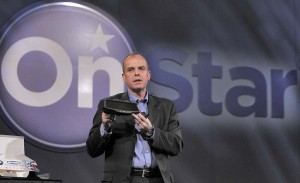
OnStar President Chris Preuss shows a new "smart" rearview mirror that can be installed in non-GM vehicles -- and will be sold through Best Buy.
By the end of this month, about 69,000 General Motors customers will use OnStar to get into their locked cars, 10,000 will use the service to call for police or an ambulance, and as many as 3 million will use OnStar to map out a route.
Yet despite the fact that the GM subsidiary is “a major profit center,” according to a senior OnStar official, it has never really lived up to its potential – until now, anyway. That’s something the company hopes to start changing with the launch of an assortment of new products and services that are being unveiled, this week, at the Consumer Electronics Show, in Las Vegas.
 While OnStar makes plenty of money, and already has six million subscribers, “We need more growth,” acknowledges the subsidiary’s President Chris Preuss, who says he sees “substantial opportunities” to pitch OnStar services to those who aren’t buying a new General Motors car, truck or crossover.
While OnStar makes plenty of money, and already has six million subscribers, “We need more growth,” acknowledges the subsidiary’s President Chris Preuss, who says he sees “substantial opportunities” to pitch OnStar services to those who aren’t buying a new General Motors car, truck or crossover.
During a CES preview, Preuss unveiled a new OnStar rearview mirror that offers Automatic Crash Response, Turn-by-Turn Navigation, Stolen Vehicle Location Assistance, one-button access to emergency and roadside services, and Bluetooth hands-free calling. To show the versatility of the new system, it was previewed on a Toyota Camry.

OnStar continues to rely on large -- and costly -- call centers for its services, but is adding more voice-control technologies.
Significantly, customers won’t have to go to a GM dealer to purchase the new smart mirror; it will be offered through the Best Buy chain.
The new OnStar system is just the most visible indication that big changes are planned for the 15-year-old operation, which was originally conceived as a way to provide an additional measure of safety and security for GM customers – while making a profit in the process.
It’s not the first time OnStar has tried to appeal to non-GM customers. Early on, the division tried to partner with other makers to offer services such as Automatic Crash Response and remote door unlocking. Lexus, Volkswagen, Audi and Isuzu were among the brands that briefly signed on, but these days, most makers have decided to go it alone, seeing such systems as both a marketing advantage and potential profit center.
Ford actually beat GM to market with a paid system of its own, but abandoned the service several years later. More recently, however, it has migrated to Sync technology, developed in cooperation with Microsoft. While there’s a charge for the basic hardware, Ford has opted to skip the monthly fee structure – which generates an average $250 a year per customer for OnStar – something it can afford to do since Ford doesn’t have to operate the heavily-staffed call centers that are a centerpiece of the OnStar operation.
It also doesn’t deliver the same sort of services. OnStar, 15 years on, continues to push its emergency response features, notably including the ability to send help after a crash, even if the driver is unconscious and unable to assist in locating the vehicle.
Ford – and other makers – are putting more of an emphasis on voice-activated infotainment features, including not only hands-free calling and navigation, but the ability to track stock prices, locate the cheapest gasoline pumps, even use synthetic speech to read text messages.
The smaller Detroit maker is introducing the ability to operate iPhone apps through the car, giving access to the Pandora music service, for example – and Ford is expected to announce even more infotainment services during the CES show, where its CEO, Alan Mulally, will serve as keynote speaker.
OnStar is playing a game of catch-up with such features, company officials acknowledge, but they also insist that, going forward, they plan to act with the lightning speed of the consumer electronics industry, rather than the traditionally sluggish pace of the automotive business.
Within the next year, according to Preuss, OnStar will add features like Google Voice Search. They are aligning with Skype, which offers inexpensive, Internet-based calling, as well as Google and telecomm provider Verizon. Tapping into Verizon’s ability to locate a caller, OnStar could customize responses, such as finding a nearby restaurant or even offering digital coupons for a free soft drink.
Until now, OnStar seldom interacted with customers outside the car – unless a subscriber was calling to open a vehicle’s doors after locking the keys inside. But the GM operation has announced a series of smartphone apps, starting with last month’s launch of the Chevrolet Volt. An owner can use the feature, among other things, to monitor the state of the plug-in hybrid’s battery charging, and even start the cabin heater by remote control, while the vehicle is still plugged into its charger.
While OnStar officials won’t discuss the service’s ability to retain its customers, they predict a major improvement in retention with their new features. But the critical challenge will be to expand beyond the GM family. The new mirror is the first step in appealing to non-GM owners. OnStar also will begin targeting buyers of used GM vehicles who have so-far chosen not to reactivate the service.
While some skeptics insist OnStar should abandon its phone banks and either reduce or even eliminate its fee structure, don’t expect that to happen. “There’s still a huge portion of the population that doesn’t like to interact with their technology” with voice or touch controls, such as those used on Sync, insists Preuss.
Indeed, Ford took a drubbing, this week, from Consumer Reports magazine, which declined to issue a Buy recommendation for the maker’s Edge and Lincoln MKT models because it felt the systems were “overly complicated.” (Click Here for the full story.)
But that also raises questions about how far OnStar can go, even with operator assistance. Distracted driving “is the biggest issue this industry has to address,” acknowledges Preuss.
If OnStar can find the right formula, however, he is betting the service will be an even bigger profit center than ever – and help sell GM vehicles in the process.
